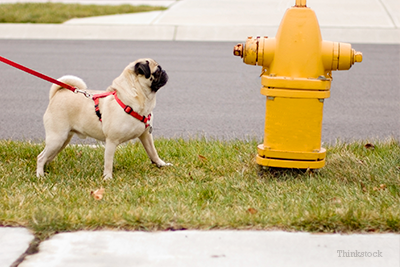
Pollakiuria is a fun word to pronounce (pol′ă-kē-yū′rē-ă), but it’s certainly not a fun symptom to deal with. Pollakiuria means increased frequency of urination. Dogs with this symptom ask to go outside more frequently than normal (often, round the clock), and the well house trained dog may begin leaving puddles in the house.
Pollakiuria caused by lower urinary tract disease
Pollakiuria is most commonly caused by abnormalities within the lower urinary tract, consisting of the bladder and urethra. The urethra is the narrow tube that transports urine from the bladder to the outside world.
Lower urinary tract diseases often cause dogs to sense the need to urinate well before the bladder is full, and the puddles produced are quite small. If ever you’ve experienced a bladder infection, no doubt you can relate to this sensation.
Common lower urinary tract maladies that cause pollakiuria include:
- Bacterial infection within the bladder, aka bacterial cystitis
- Stones within the bladder or urethra
- Tumors or polyps within the bladder or urethra
Pollakiuria caused by increased thirst
Some diseases causing pollakiuria are associated with increased thirst (polydipsia). Excess water intake and excess urine production (polyuria) go hand in hand. The bladder fills more rapidly and frequently, and the puddles produced are quite large. Causes of increased thirst and urine production include:
1. Hormonal imbalances
- Diabetes mellitus
- Diabetes insipidus
- Hyperadrenocorticism (Cushing’s disease)
2. Kidney disease
- Chronic kidney disease
- Pyelonephritis (kidney infection)
3. Liver disease
4. Pyometra
5. Medications
- Cortisone containing products
- Anti-seizure medications
- Diuretics
Recognizing pollakiuria
Some pollakiuric dogs show extremely overt symptoms (a bedside puddle greets you first thing in the morning). Other dogs show more subtle symptoms. Be on the lookout for:
- Increased frequency of urination on walks
- Interrupted sleep because your dog is asking to go outside
- The need to fill the water bowl more frequently than usual
If such symptoms arise, I encourage you to:
- Schedule a visit with your veterinarian
- Do your best to arrive with a full bladder (your pet’s that is)
Testing a urine sample will be an important first step in arriving at a diagnosis. This is best accomplished by keeping your dog under lock and key for a few hours before the office visit. Get into the waiting room quickly, so as to avoid those many tempting places to urinate just outside the clinic.
Questions to ask your veterinarian
- What tests can be performed to determine the cause of the pollakiuria?
- What causes of pollakiuria have been ruled out?
- Do we know why my pet has pollakiuria?
If you have any questions or concerns, you should always visit or call your veterinarian -- they are your best resource to ensure the health and well-being of your pets.
